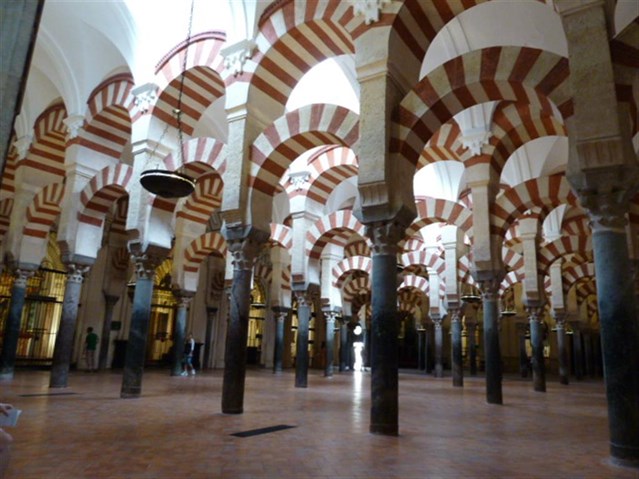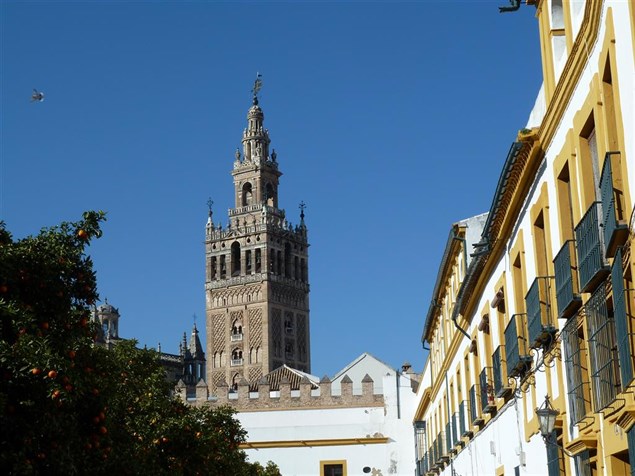Córdoba, Seville, and Nature from Madrid by train
Córdoba, Seville, and Nature from Madrid by train
We propose this interesting getaway to Andalusia, for 3 days and 2 nights to discover Cordoba, Seville, and breathe the clean air of Sierra Morena, visiting the white villages of Seville.
Córdoba, also known as the city of the three cultures and the capital of Muslim Spain, is the geographical center of Andalusia. A tourist and monumental city developed along the Guadalquivir River from east to west. Every corner of its streets is filled with that Arab essence that can still be felt in its Jewish quarter; and of course, its main tourist attraction, the Mosque-Cathedral of Cordoba, along with its Alcazar and Roman Bridge, make the historic center a true delight for visitors.

El Pedroso is a haven of tranquility, just an hour from the capital of Andalusia, a small white village nestled in the Sierra Norte Natural Park of Seville, the perfect place to disconnect from the noise of the capital and enjoy nature in all its splendor.

Seville, the capital of Andalusia and the fourth most populous city in Spain. A charming and welcoming city, rich in history and blessed with a climate that allows for enjoyment year-round. The history of Seville dates back to its earliest inhabitants, such as the Tartessians, followed by the Roman presence leaving significant vestiges still present in our city. Most notably, the art and influence of the Muslim population, still evident in the typical architecture of the city as well as throughout Andalusia.

DAY 1: SATURDAY, JANUARY 27, 2024 MADRID - CORDOBA - ALMODÓVAR DEL RÍO CASTLE - SIERRA MORENA NATURAL PARK OF SEVILLE (EL PEDROSO)
07:55 Departure from Madrid Atocha by high-speed train.
09:46 Arrival in Córdoba. Upon arrival, we will be greeted by a local guide who will provide a historical explanation of the place before we proceed to discover this beautiful city. Córdoba was the capital of Al-Andalus, the heart of the Umayyad Caliphate. A city that, in its time, was compared to Constantinople for its cultural richness, architecture, and grandeur.
We will enter the Medina through the Almodóvar Gate and stroll through the Jewish Quarter, where we can visit the synagogue, the only one preserved in Andalusia dating back to 1314. We will continue walking through the streets of the Medina, exploring the monumental area of the city, including the Roman Bridge and the Mosque-Cathedral.
Later, we will wander through the winding and narrow streets of the old quarter, with a special stop at the Calleja de las Flores. Then, we will descend to the medieval quarter to discover historically rich spaces such as Plaza del Potro and La Corredera.
The Plaza del Triunfo owes its name to the monument located at one of its ends, the famous Triunfo de San Rafael, a vertical monument crowned by the guardian archangel, the protector of the city.
Lunch will be served at a renowned restaurant in the city, where we will have the opportunity to enjoy Cordoban gastronomy.
Next, we will head to Medina Azahara, a palatial city from the 10th century. The history of Medina Azahara began with Abderraman III's decision to build a city on the outskirts of Córdoba between the years 936 and 976. It encompasses both administrative and residential spaces of the caliphate. Taking advantage of the terrain's topography, a city was designed based on existing heights, with the upper terrace occupied by the royal family's private function and residence, as well as the governmental function.
After visiting Medina Azahara, we will continue to one of the best-preserved castles in Spain, Almodóvar del Río Castle, where we will stop for photos without visiting the interior.
Continuing towards Sierra Morena, we will reach our destination: El Pedroso.
Room assignment.
Welcome mountain dinner and accommodation in El Pedroso in a 19th-century manor house.
DAY 2: SUNDAY, JANUARY 28, 2024 WHITE VILLAGES OF SEVILLE - DISTILLERIES, WINES, AND MOUNTAIN GASTRONOMY
Breakfast.
09:00 Departure to Constantina to visit an ancestral distillery of spirits. The history of aniseed in Constantina arises because it has always been land of vineyards. Since ancient times, the Romans appreciated this wine, called cocolubis by them, so much that they took it to Rome. At the end of the 16th century, there was such a production of grapes that the surplus wine was transformed into alcohol, and it was then that the first aniseed industries began to emerge. The distillery we visit continues to produce aniseed and liqueurs, nowadays in the same copper stills used by those famous brands, feeding the still with holm oak firewood, thus maintaining the same production techniques from centuries ago and producing a typical and autochthonous product such as our specialty: "Cherry Cream." Anise and cherry tasting included. After a stroll through Constantina, we will continue to El Cerro de Hierro, which harbors a spectacular landscape where nature and human action come together, resulting in a paleokarst of great beauty and scientific and didactic interest.
We will then head to Batán de las Monjas, where we will stop for lunch in a beautiful natural setting, currently the best gastronomic spot in the area. From there, we will head to the Carthusian Monastery of Cazalla, which originated in the late 15th century and is a magnificent example of monumental architectural complexes where the life of the Carthusian Order developed.
In the afternoon, we will continue our route to Cazalla de la Sierra, a beautiful place where we will stroll through its streets and have the opportunity to visit a vineyard and witness the wine production of this region of Andalusia.
Upon our return, we will take a walk through the village.
Dinner in El Pedroso. Accommodation in El Pedroso, Seville
Length
3 days and 2 nights
8 Persons --> 525 €
10 Persons --> 500 €
12 Persons --> 475 €
Terms and conditions
- The price includes:
- High-speed train from Madrid to Córdoba
- High-speed train from Seville to Madrid
- Private transportation in a minivan during the three-day stay
- Accompanying guide during the stay and on excursions from arrival to departure
- 2 nights accommodation in a double room at Boutique Hotel Entreolivos, in El Pedroso, Seville
- 2 breakfasts
- 2 dinners
- 2 lunches at restaurants in Córdoba and Cazalla de la Sierra
- Tapas route in Seville
- Guided tour of the historic center of Seville
- Guided tour of the historic and monumental center of Córdoba
- Visit to the white villages of the Sierra Norte de Sevilla, Constantina, Cazalla, and El Pedroso
- Visit to a distillery with over 200 years of history
- Visit to vineyards and wineries in Cazalla de la Sierra
- Entrance to a flamenco show in Seville
- Local guide in Seville
- Local guide in Córdoba
- Not included:
- Assistance or cancellation expense insurance, optional to purchase.
- Single room supplement €40
- Any other service not specified in the price includes
- OPTIONAL EXTRA NIGHT IN SEVILLE AND ACCOMMODATION IN SEVILLE
- €120 Double room with breakfast Hotel Las Casas del Arenal 4* January 29, 2024
- PROPOSED ACCOMMODATION
- Hotel Entreolivos. Boutique hotel, in a manor house, in the urban center of El Pedroso. Province of Seville.
- It has 8 double rooms and 1 triple room. It has a pool to enjoy during the hot months and a fireplace lounge for the winter.
- Easy parking.
- The Pedroso train station is a one-minute walk from the hotel.
- MEALS
- This program includes 2 dinners, 2 lunches, and 3 breakfasts.
- Also, the accompanying guide will recommend good places to eat or have tapas in Seville and Córdoba.
- CANCELLATION FEES
- At any time, the client may cancel the requested or contracted services, being entitled to the refund of the amounts paid, but must indemnify the organizer or retailer in the amounts indicated:
- Management fees €15 per person
- 7 days before departure per person cancellation fees: €30
- Furthermore,
- a) A penalty consisting of 5% of the total amount of the trip, if the cancellation occurs more than ten and less than fifteen days before the start date of the trip.
- b) A penalty consisting of 15% of the total amount of the trip if the cancellation occurs between three and ten days before the start date of the trip, and
- c) A penalty consisting of 25% of the total amount of the trip if the cancellation occurs within forty-eight hours prior to the trip departure.
- In case of no-show, the client is obliged to pay the total amount of the trip, paying the outstanding amounts, if any.

Additional Information
N/D